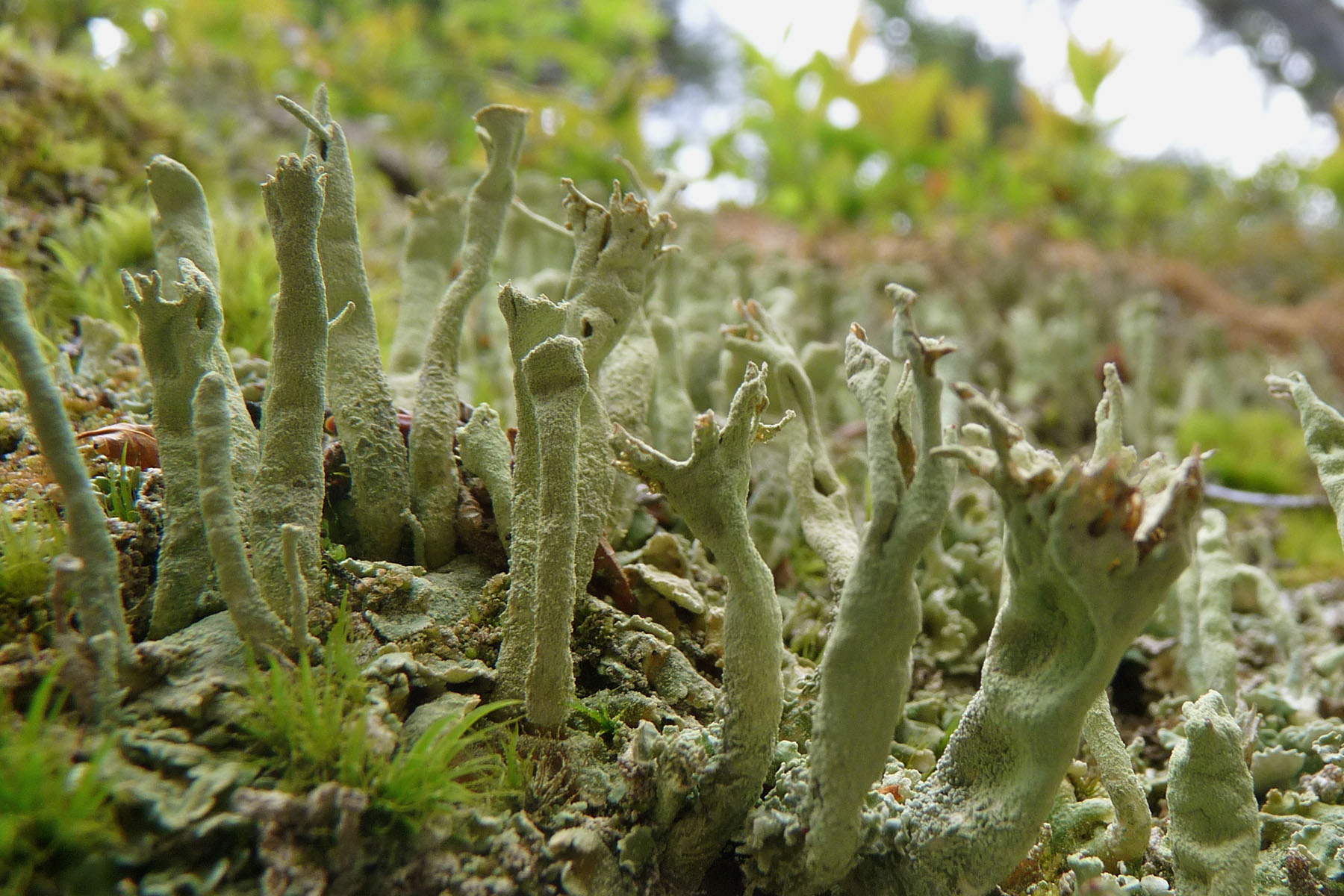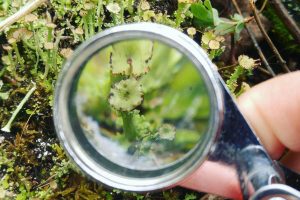On June 29, ABMI lichenologist Dr. Diane Haughland presented Lichens of Alberta, the second in our It’s Our Nature to Know webinar series. Diane studies the taxonomy and ecology of Alberta’s lichens, and her team is responsible for identifying thousands of lichens from across the province each year to help track changes in Alberta’s biodiversity. We caught up with Diane for a quick chat before the webinar. You can now view the webinar on the ABMI’s YouTube channel HERE.
What are lichens?
Lichens are composite organisms consisting of at least one fungus and one photosynthetic alga or cyanobacterium—the fungus contributes structure, while the photosynthetic partner provides sugars. More and more we are discovering that they also house complex communities of additional microorganisms.
Like many organisms, lichens act as reservoirs of diversity, and the structure or habitat they provide creates niches for other organisms both within and outside of the lichen.
And philosophically, lichens act as a metaphor for the thin skiff of life on the rock we call planet earth. Lichens themselves often form that thin skin that regulates the temperature and moisture of the ecosystems they are a part of, particularly in harsh environments where lichens can dominate.
What can we learn from lichens?
A lot! Lichens are like Albertans—diverse and resilient, but also sensitive to their environment and reliant on our natural resources. Lichens are year-round residents of cities, forests and grasslands (they’re not snowbirds), and studying their distribution and ecology helps us understand how human activities are impacting biodiversity across the province. The fact that lichens are found in every terrestrial landscape, are sensitive to changes in their environment, and can’t run away makes them great study organisms.
Lichens contribute to quite a few ecosystem functions, from harboring diversity within them, to making nitrogen available to other species, stabilizing soil, and fixing carbon. Lichens are also excellent indicators of biodiversity, with different species showing sensitivity to habitat loss or alteration, climate change, and air quality. Understanding how lichens are faring at a given location can reveal changes in these habitat or environmental factors, and provide insight into how other taxa that are more difficult to survey might be impacted.
What are some specific projects you and your team are working on now?
In the grasslands, we’re working with Dr. Cameron Carlyle and MSc student Megan Lewis (University of Alberta) exploring how lichen diversity and richness is impacted by grazing and drought, and in the north, we’re modelling how individual lichens decline with different types of human activity. Along with a group of students and volunteers, we’re documenting Edmonton’s lichen diversity, in part to understand what it can tell us about air quality. And part of supporting sustainable development is growing the awareness and appreciation of these beautiful and fascinating communities, so we engage in public outreach and projects such as nominating a provincial lichen.
Other projects include testing whether samples collected in the past can be used to estimate relative pollution levels across Alberta. And we’re partners on a project led by Dr. François Lutzoni, Dr. Jolanta Miadlikowska and PhD student Carlos Pardo De la Hoz exploring the factors that shape the partnerships in lichens whose primary photosynthetic partner is a cyanobacterium.
What have you and your team learned so far?
Lichens have so much to tell us, but before any of that we have to know what we’re looking at. Lichens have historically been overlooked and understudied, so a big part of our work is rectifying that through taxonomic research. Putting a name to a specimen involves a lot of research and science, and that science is constantly evolving. Accurately identifying lichens means that we can better understand the sensitivity and ecology of those species, and whether they are generalists that occur across the province (or around the world), rare habitat specialists, or even new species to science!
So far, we’ve described or are investigating 10 species that are completely new to science, 2 that are new to Canada, 3 that are new to Western Canada, and 80 that are new to Alberta.
Based on this fundamental taxonomic research, we’ve been able to estimate the ‘baseline’ distribution of lichen species across the province and understand species–habitat associations that facilitate using lichens as indicator species, and we’re in the process of redefining the rarity and conservation rankings of many of Alberta’s lichen species.
What do you find most rewarding about your work?
So much of what I do is rewarding! It’s why I’m still doing it after 10 years. I’m an ecologist by training, so it did surprise me how much I’ve enjoyed digging into and updating the taxonomy of our lichen flora. The more we dig in, the more we realize just how much diversity Alberta is housing. Lichens have so many stories to tell and lessons for us to learn, and we’ve only just begun to listen!
The Lichens of Alberta webinar will run live noon – 1:00 pm on June 29. Register for free HERE. The webinar will also be made available through the ABMI’s YouTube channel after the event is over.



